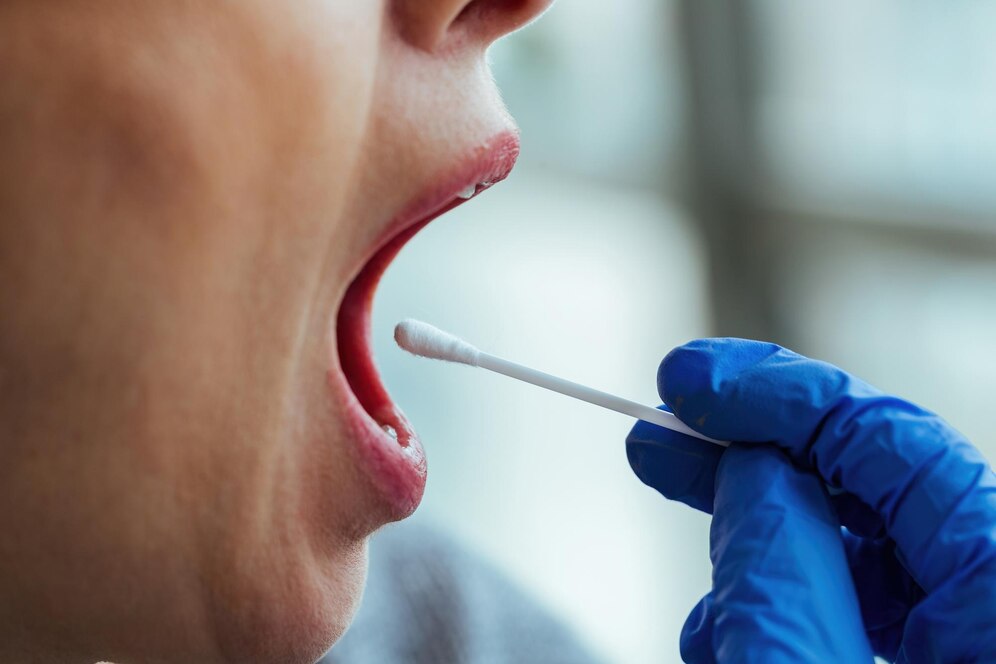How Long Does a Strep Test Take? Your Quick Guide to Diagnosis

A sore throat can quickly derail your plans, and the worry of strep throat adds another layer of discomfort. Luckily, getting a strep test is a quick and simple way to determine the cause of your symptoms. Let’s explore how long the different types of strep tests take, what to expect during the process, and when to seek professional care.
How Long Does a Rapid Strep Test Take? Unveiling the Quick Results
- The Swab: The rapid strep test (RST) starts the same as a throat culture – your doctor or nurse practitioner will use a long cotton swab to collect a sample from the back of your throat and tonsils.
- Antigen Detection: The swab is then placed in a solution that extracts antigens, unique proteins found on the surface of the strep bacteria (Group A Streptococcus).
- Antibody Binding: The solution is mixed with a test strip containing antibodies that bind specifically to strep antigens.
- Quick Results: If strep bacteria are present, the antigens will bind to the antibodies, causing a visible color change on the test strip within minutes.
Why It’s Fast: The RST doesn’t require bacteria to grow, it simply detects the presence of their identifying proteins.
Drawbacks:
- Less Sensitive: It might miss a strep infection if there aren’t enough bacteria in the sample to trigger a strong enough signal on the test strip.
- False Negatives: This is why a negative RST might still be followed by a throat culture for confirmation, especially in children or if your doctor strongly suspects strep.
How Long Does a Throat Culture Take? Growing the Evidence
- The Same Swab, Different Outcome: Like the RST, a throat culture starts with a swab of your tonsils and the back of your throat.
- Culturing the Bacteria: The swab is then placed on a special petri dish containing nutrients that allow bacteria to grow (if present).
- Waiting Game: This dish is incubated (kept warm) for 1-2 days, allowing any strep bacteria to multiply.
- Identification: If colonies of strep bacteria grow, it confirms a diagnosis.
Why It’s More Accurate: By allowing the bacteria to multiply, the throat culture becomes more sensitive and can detect even small amounts of strep.
Drawbacks:
- The Wait: While more accurate, the downside is the time it takes to get definitive results. This can delay starting antibiotic treatment.
The Choice Between Tests
Your doctor or nurse practitioner will decide which test is most appropriate based on your symptoms, medical history, and the prevalence of strep in the community. Often, both tests are performed simultaneously to ensure the most accurate and timely diagnosis.
When Should I Get a Strep Test? Signs to Look For
A sore throat doesn’t automatically mean strep throat, but it’s important to be vigilant and seek a test if you experience the following signs:
- Sudden and Severe Sore Throat: Strep throat often comes on quickly and causes intense pain in your throat, especially when swallowing. This pain is often more severe than a typical sore throat caused by a cold or flu.
- Fever: A high fever (often over 101°F) is a common sign of a strep infection. This fever usually starts quickly and can be accompanied by chills.
- Swollen Lymph Nodes: The lymph nodes in your neck might become enlarged and tender to the touch.
- White or Yellow Patches on Tonsils: These are a hallmark sign of strep throat. The tonsils may also appear red and swollen.
- Difficulty Swallowing: Severe pain when swallowing is a common indicator of strep throat. This can make eating and drinking uncomfortable.
- Headache: Strep throat is often accompanied by a headache.
- Body Aches: Some people experience fatigue, body aches, and a general feeling of malaise with strep throat.
- Absence of Cough: While a cough is common with a cold or flu, it’s usually less prominent in strep throat.
Additional Considerations:
- Age: Strep throat is more common in children and adolescents but can occur at any age.
- Exposure: If you’ve been in close contact with someone diagnosed with strep throat, it’s crucial to get tested as the infection is highly contagious.
Don’t Delay Diagnosis
If you experience any of these symptoms, don’t hesitate to schedule an appointment with a healthcare professional like your primary care doctor or nurse practitioner. Prompt diagnosis and treatment with antibiotics can prevent complications and shorten the duration of the illness.
Remember: While strep throat is a common infection, it shouldn’t be taken lightly. A simple strep test can provide the answers you need to get appropriate treatment and feel better quickly.
Please note that this is just a general guideline. Your doctor or healthcare provider will assess your symptoms and individual circumstances to determine if a strep test is necessary.
Seeking Expert Care in Miami, FL
Don’t hesitate to seek a professional evaluation if you suspect strep throat or are experiencing any concerning symptoms. Our experienced primary care doctors at Hiriart & Lopez MD in Miami can perform strep tests, diagnose your condition accurately, and provide appropriate treatment. Call our office at (305) 274-8779 or visit us at 9950 SW 107th Ave STE 101, Miami, FL, 33176. You can also request an appointment online on our website.
Disclaimer: This information is for educational purposes only and does not replace professional medical advice. Always consult with a qualified healthcare provider for diagnosis and treatment.
Contact Us
Hiriart & Lopez MD, LLC
9950 SW 107th Ave STE 101,
Miami, FL 33176
305-274-8779
Phone: (305) 274-8779
Fax: (305) 274-0646
OPENING HOURS
Monday 7:30 AM–4:30 PM
Tuesday 7:30 AM–4:30 PM
Wednesday 7:30 AM–4:30 PM
Thursday 7:30 AM–4:30 PM
Friday 7:30–11 AM
Saturday Closed
Sunday Closed
OFFICE LOCATION
How Long Does a Strep Test Take? Your Quick Guide to Diagnosis

A sore throat can quickly derail your plans, and the worry of strep throat adds another layer of discomfort. Luckily, getting a strep test is a quick and simple way to determine the cause of your symptoms. Let’s explore how long the different types of strep tests take, what to expect during the process, and when to seek professional care.
How Long Does a Rapid Strep Test Take? Unveiling the Quick Results
- The Swab: The rapid strep test (RST) starts the same as a throat culture – your doctor or nurse practitioner will use a long cotton swab to collect a sample from the back of your throat and tonsils.
- Antigen Detection: The swab is then placed in a solution that extracts antigens, unique proteins found on the surface of the strep bacteria (Group A Streptococcus).
- Antibody Binding: The solution is mixed with a test strip containing antibodies that bind specifically to strep antigens.
- Quick Results: If strep bacteria are present, the antigens will bind to the antibodies, causing a visible color change on the test strip within minutes.
Why It’s Fast: The RST doesn’t require bacteria to grow, it simply detects the presence of their identifying proteins.
Drawbacks:
- Less Sensitive: It might miss a strep infection if there aren’t enough bacteria in the sample to trigger a strong enough signal on the test strip.
- False Negatives: This is why a negative RST might still be followed by a throat culture for confirmation, especially in children or if your doctor strongly suspects strep.
How Long Does a Throat Culture Take? Growing the Evidence
- The Same Swab, Different Outcome: Like the RST, a throat culture starts with a swab of your tonsils and the back of your throat.
- Culturing the Bacteria: The swab is then placed on a special petri dish containing nutrients that allow bacteria to grow (if present).
- Waiting Game: This dish is incubated (kept warm) for 1-2 days, allowing any strep bacteria to multiply.
- Identification: If colonies of strep bacteria grow, it confirms a diagnosis.
Why It’s More Accurate: By allowing the bacteria to multiply, the throat culture becomes more sensitive and can detect even small amounts of strep.
Drawbacks:
- The Wait: While more accurate, the downside is the time it takes to get definitive results. This can delay starting antibiotic treatment.
The Choice Between Tests
Your doctor or nurse practitioner will decide which test is most appropriate based on your symptoms, medical history, and the prevalence of strep in the community. Often, both tests are performed simultaneously to ensure the most accurate and timely diagnosis.
When Should I Get a Strep Test? Signs to Look For
A sore throat doesn’t automatically mean strep throat, but it’s important to be vigilant and seek a test if you experience the following signs:
- Sudden and Severe Sore Throat: Strep throat often comes on quickly and causes intense pain in your throat, especially when swallowing. This pain is often more severe than a typical sore throat caused by a cold or flu.
- Fever: A high fever (often over 101°F) is a common sign of a strep infection. This fever usually starts quickly and can be accompanied by chills.
- Swollen Lymph Nodes: The lymph nodes in your neck might become enlarged and tender to the touch.
- White or Yellow Patches on Tonsils: These are a hallmark sign of strep throat. The tonsils may also appear red and swollen.
- Difficulty Swallowing: Severe pain when swallowing is a common indicator of strep throat. This can make eating and drinking uncomfortable.
- Headache: Strep throat is often accompanied by a headache.
- Body Aches: Some people experience fatigue, body aches, and a general feeling of malaise with strep throat.
- Absence of Cough: While a cough is common with a cold or flu, it’s usually less prominent in strep throat.
Additional Considerations:
- Age: Strep throat is more common in children and adolescents but can occur at any age.
- Exposure: If you’ve been in close contact with someone diagnosed with strep throat, it’s crucial to get tested as the infection is highly contagious.
Don’t Delay Diagnosis
If you experience any of these symptoms, don’t hesitate to schedule an appointment with a healthcare professional like your primary care doctor or nurse practitioner. Prompt diagnosis and treatment with antibiotics can prevent complications and shorten the duration of the illness.
Remember: While strep throat is a common infection, it shouldn’t be taken lightly. A simple strep test can provide the answers you need to get appropriate treatment and feel better quickly.
Please note that this is just a general guideline. Your doctor or healthcare provider will assess your symptoms and individual circumstances to determine if a strep test is necessary.
Seeking Expert Care in Miami, FL
Don’t hesitate to seek a professional evaluation if you suspect strep throat or are experiencing any concerning symptoms. Our experienced primary care doctors at Hiriart & Lopez MD in Miami can perform strep tests, diagnose your condition accurately, and provide appropriate treatment. Call our office at (305) 274-8779 or visit us at 9950 SW 107th Ave STE 101, Miami, FL, 33176. You can also request an appointment online on our website.
Disclaimer: This information is for educational purposes only and does not replace professional medical advice. Always consult with a qualified healthcare provider for diagnosis and treatment.
Contact Us
Hiriart & Lopez MD, LLC
9950 SW 107th Ave STE 101,
Miami, FL 33176
305-274-8779
Phone: (305) 274-8779
Fax: (305) 274-0646
OPENING HOURS
Monday 7:30 AM–4:30 PM
Tuesday 7:30 AM–4:30 PM
Wednesday 7:30 AM–4:30 PM
Thursday 7:30 AM–4:30 PM
Friday 7:30–11 AM
Saturday Closed
Sunday Closed

